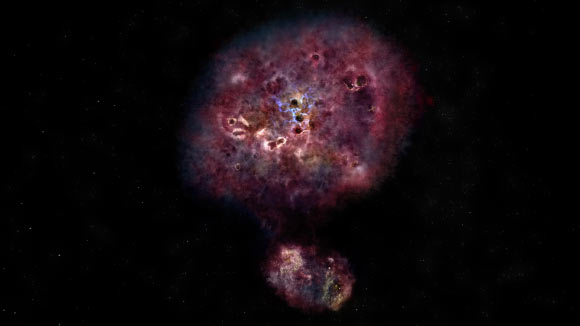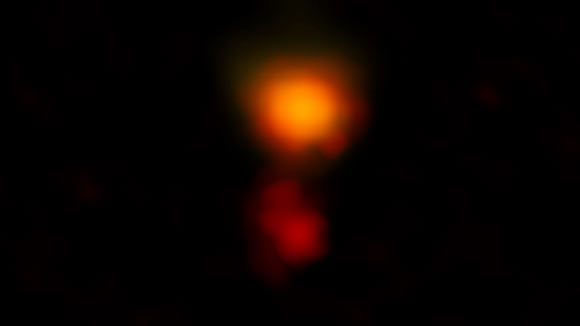Merging Pair of Dusty Star-Forming Galaxies Spotted 13 Billion Light-Years Away | Astronomy – Sci-News.com
Using the Atacama Large Millimeter/submillimeter Array (ALMA), an international team of astronomers has spotted an unlensed, dusty star-forming galaxy system in the early Universe. Dubbed MAMBO-9 (also known as MM J100026.36+021527.9), the system is composed of a pair of galaxies separated by approximately 20,000 light-years. The light from MAMBO-9 traveled about 13 billion years to reach Earth.

An artist’s impression of what the dusty star-forming galaxy MAMBO-9 would look like in visible light. Image credit: NRAO / AUI / NSF / B. Saxton.
Dusty star-forming galaxies are the most intense stellar nurseries in the Universe. They contain huge amounts of gas and dust and form stars at a rate up to a few thousand solar masses per year.
Such monster galaxies are not expected to have formed early in the history of the Universe, but astronomers have already discovered several of them as seen when the cosmos was less than a billion years old.
Because of their extreme behavior, astronomers think that these dusty galaxies play an important role in the evolution of the Universe.
“These galaxies tend to hide in plain sight. We know they are out there, but they are not easy to find because their starlight is hidden in clouds of dust,” said Dr. Caitlin Casey, an astronomer at the University of Texas at Austin.
MAMBO-9 was first detected 10 years ago by the Max-Planck Millimeter BOlometer (MAMBO) instrument on the IRAM 30-m telescope in Spain and the Plateau de Bure Interferometer in France. But those observations were not sensitive enough to reveal the distance.
“We were in doubt if it was real, because we couldn’t find it with other telescopes. But if it was real, it had to be very far away,” said Dr. Manuel Aravena, a researcher at the Universidad Diego Portales in Chile.

ALMA radio image of MAMBO-9. Image credit: ALMA / ESO / NAOJ / NRAO / Casey et al / AUI / NSF / B. Saxton.
Thanks to ALMA’s sensitivity, the team has now been able to determine the distance of MAMBO-9.
“We found the galaxy in a new ALMA survey specifically designed to identify dusty star-forming galaxies in the early Universe. And what is special about this observation, is that this is the most distant dusty galaxy we have ever seen in an unobstructed way,” Dr. Casey said.
The scientists saw MAMBO-9 directly, without a gravitational lens, and this allowed them to measure its mass.
“The total mass of gas and dust in the galaxy is enormous: 10 times more than all the stars in the Milky Way. This means that it has yet to build most of its stars,” Dr. Casey said.
The astronomers hope to find more distant dusty galaxies in the ALMA survey, which will give insight into how common they are, how these massive galaxies formed so early in the Universe, and why they are so dusty.
The discovery of MAMBO-9 is described in a paper in the Astrophysical Journal.
_____
Caitlin M. Casey et al. 2019. Physical Characterization of an Unlensed, Dusty Star-forming Galaxy at z = 5.85. ApJ 887, 55; doi: 10.3847/1538-4357/ab52ff






